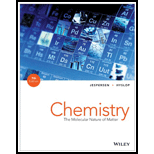
Concept explainers
Interpretation:
The chemical formula for each of the given coordination complexes is to be written.
Concept Information:
Complex ions are ions formed by a metal atom at their center such that, other nonmetal molecules or ions surround it.
Ligands are molecules or ions that are bonded to a metal ion with a coordinate covalent bond.
Coordination complexes are complexes that are formed by a coordinate covalent bond between ligands and metals.
To write the formula for a complex, following rules are utilized:
The symbol for the metal ion is always given first, followed by the ligands.
When more than one kind of ligand is present, anionic ligands are written first (in alphabetical order), followed by neutral ligands (also in alphabetical order).
The charge on the complex is the algebraic sum of the charge on the metal ion and the charges on the ligands.
The formula is placed inside of the square brackets with the charge of the complex ion as a superscript outside the brackets. When the charge is zero the brackets and charge are omitted.
Want to see the full answer?
Check out a sample textbook solution
Chapter 21 Solutions
Chemistry: The Molecular Nature of Matter
- Four different octahedral chromium coordination compounds exist that all have the same oxidation state for chromium and have H2O and Cl as the ligands and counterions. When 1 mole of each of the four compounds is dissolved in water, how many moles of silver chloride will precipitate upon addition of excess AgNO3?arrow_forwardPlatinum(II) forms many complexes, among them those with the following ligands. Give the formula and charge of each complex. (a) two ammonia molecules and one oxalate ion (C2O42-) (b) two ammonia molecules, one thiocyanate ion (SCN-), and one bromide ion (c) one ethylenediamine molecule and two nitrite ionsarrow_forwardTwo different compounds are known with the formula Pd(py)2Cl2, but there is only one compound with the formula Zn(py)2Cl2. The symbol py is for pyridine, a mono-dentate ligand. Explain the differences in the Pd and Zncompounds.arrow_forward
 Chemistry: Principles and ReactionsChemistryISBN:9781305079373Author:William L. Masterton, Cecile N. HurleyPublisher:Cengage Learning
Chemistry: Principles and ReactionsChemistryISBN:9781305079373Author:William L. Masterton, Cecile N. HurleyPublisher:Cengage Learning Chemistry: The Molecular ScienceChemistryISBN:9781285199047Author:John W. Moore, Conrad L. StanitskiPublisher:Cengage Learning
Chemistry: The Molecular ScienceChemistryISBN:9781285199047Author:John W. Moore, Conrad L. StanitskiPublisher:Cengage Learning Chemistry: An Atoms First ApproachChemistryISBN:9781305079243Author:Steven S. Zumdahl, Susan A. ZumdahlPublisher:Cengage Learning
Chemistry: An Atoms First ApproachChemistryISBN:9781305079243Author:Steven S. Zumdahl, Susan A. ZumdahlPublisher:Cengage Learning
 ChemistryChemistryISBN:9781305957404Author:Steven S. Zumdahl, Susan A. Zumdahl, Donald J. DeCostePublisher:Cengage Learning
ChemistryChemistryISBN:9781305957404Author:Steven S. Zumdahl, Susan A. Zumdahl, Donald J. DeCostePublisher:Cengage Learning Principles of Modern ChemistryChemistryISBN:9781305079113Author:David W. Oxtoby, H. Pat Gillis, Laurie J. ButlerPublisher:Cengage Learning
Principles of Modern ChemistryChemistryISBN:9781305079113Author:David W. Oxtoby, H. Pat Gillis, Laurie J. ButlerPublisher:Cengage Learning





